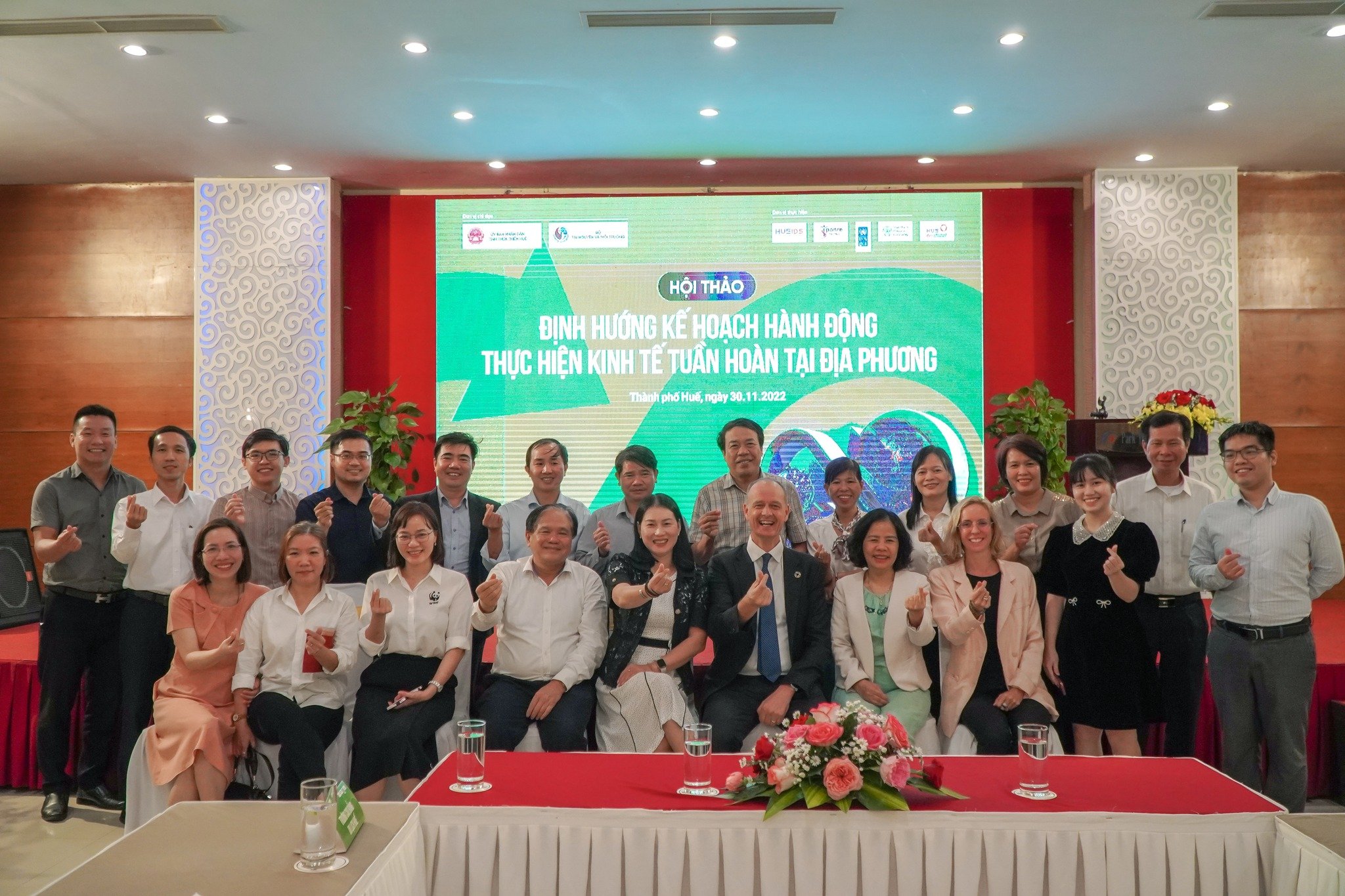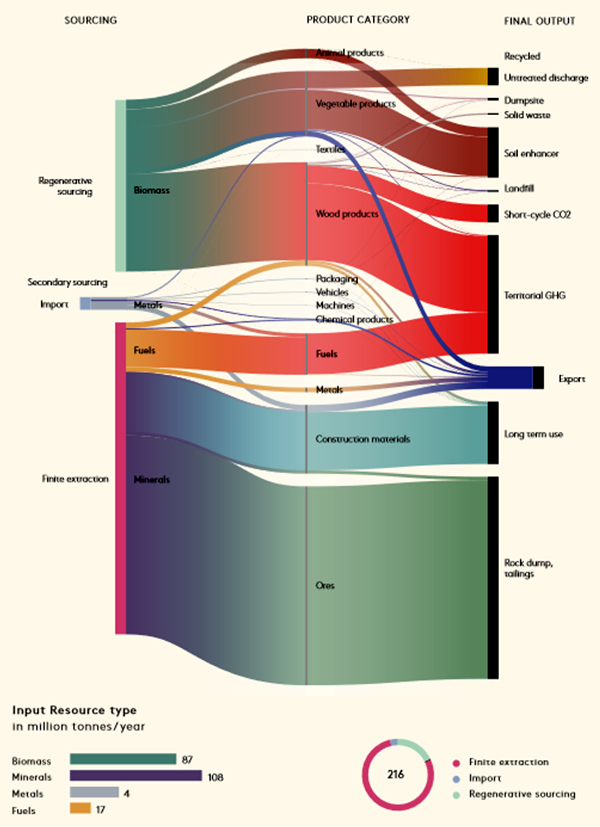Embarking in the transition toward a Circular Economy, one flow of material at a time
February 15, 2023

This blog is the first in a three-part series that shares UNDP and HueIDS’s circular journey in Thua Thien Hue province.
By Morgane Rivoal (UNDP Viet Nam), Hai Cao Quoc (HueIDS), Jelmer Hoogzaad (Shifting Paradigms), Hoang Thanh Vinh and Merran Eby (UNDP Viet Nam)
In the transition towards a circular economy (CE), nobody starts from scratch. Thua Thien Hue province, which is already home to many green businesses and grassroots circular initiatives, is certainly no exception. The ancient capital of Hue City, which was home to the Nguyen dynasty for more than 150 years, welcomes around 3–4 million visitors annually and aspires to transition to green tourism.
The CE transition is high on Viet Nam’s political agenda. In his ground-breaking statement at COP26 announcing the country’s intent to reach net zero emissions by 2050, Prime Minister Pham Minh Chinh highlighted the need for a “green, circular, sustainable, inclusive, and humanistic economy.” CE was first defined in the 2020 Law on Environmental Protection , and has since made its way into the country’s Socio-Economic Development Plan and Strategy and the Master Plan on Circular Economy . Viet Nam’s next key milestone is to formulate a National Action Plan on CE that will establish priority sectors, a monitoring and evaluation framework, and ministerial responsibilities.
That said, transitioning to a circular economy is no easy task: it requires new models and respective shifts in how policy and investment decisions are made, as well as the data to support those decisions. When the Hue Institute for Development Studies (HueIDS), a think tank hosted by the Provincial People’s Committee, got tasked with formulating a circular economy (CE) roadmap, they were confronted with two key questions: how can we bring coherence to an ambitious constellation of development priorities , and then how we can organize collective action to achieve it?
In order to tackle these twin challenges, the United Nations Development Programme (UNDP) and HueIDS are joining forces to conduct metabolic research in Thua Thien Hue province, with funding from the Norwegian Agency for Development Cooperation (Norad).
Why does it matter, what are we doing, and how are we doing it? This blog shares some answers.
Why: Making Circular Economy Work in Viet Nam’s Provinces
The Master Plan for CE Development in Viet Nam aims to reduce GHG emissions per GDP by at least 15% in 2030; promote sustainable production and consumption by setting a target of 85% plastic recycled in 2025, improve waste management in urban areas such as 100% organic waste in urban areas is recycled, maximized wastewater recycling rate etc. Many of such circular and orientations are related to cities.
Urbanisation rates in Viet Nam are skyrocketing, and are expected to reach 50% by 2030. The circular economy holds a promise of reduced environmental pollution, socio-economic development, cost-efficiency, and efficient use of natural resources. Thua Thien Hue Province has embraced the circular economy as one of the pillars of its modernisation strategy. It is therefore not surprising to witness these looking to quickly seize the opportunities that a strategic, fully-fledged, sector-wide CE transition could bring. Within the south of Thua Thien Hue Province, Da Nang City is already pioneering this circular transition. Under the leadership of Da Nang Institute for Socio-Economic Development (DISED), and with the support of UNDP and the Finnish think tank SITRA, they have been forging ahead with the formulation and adoption of city-level CE policies by leveraging learning based on the results of local pilot projects (full story here).
Cities are where resources, capital, and people are concentrated. It is where material flows converge along with their environmental, economic, and social impacts. Therefore, cities are focal points for the development of circular business models, such as sharing and reuse systems, or product-as-a-service models. Intervening in the interaction between the producer and the consumer is an important principle of the circular economy, as it helps reduce finite extraction upstream while avoiding waste downstream in product value chains.
What: From Setting the Direction to Mapping Material Flows and Policy Formulation – Thua Thien Hue’s Journey
The Provincial People Committee of Thua Thien Hue province set the ambitious vision of “becoming a municipality that preserves and promotes the values of the ancient capital's heritage and Hue’s cultural identity, with the characteristics of culture, heritage, ecology, environment-friendly, and smart urban landscape”, when adopting the Resolution of the 16th Provincial Party Congress.
The main purpose of this research is to inform the formulation of Thua Thien Hue’s provincial CE roadmap, listing practical and investable solutions. The evidence, information, and insights from the metabolic analysis support priority setting, and the identification of the most suitable circular economy interventions. For these interventions the environmental and socio-economic impacts will be assessed, allowing policy-makers to prioritise, adequately allocated scarce public resources and understand how the circular economy fits into broader development ambitions and targets.
What do cement kilns, rice straw burning, and tourists riding e-bikes have in common? They all require the extraction, conversion, consumption, and use of finite resources. In a metabolic analysis resource flows are analysed as a system, depicting data on cross-border trade, extraction, production, processing, and the disposal of goods and materials. The impact of the current economy on the natural capital which provides material inputs, determines the ability of future generations to thrive.
The study team – comprised of senior officers at HueIDS, national experts, and an experienced international metabolic researcher – approached their work with one goal in mind: capture all the resources and material flows that are being used in Thua Thien Hue, from extraction to use to end-of-life. The pace at which the building stock is expanding, the food losses along food value chains, the greenhouse gas emissions from rice production, and the number of tourist arrivals per year: all have a place in the metabolic analysis. There are plenty of opportunities for circular businesses to thrive but some may require gradual changes in the rules of the game and, for example, how public institutions collect necessary financial means or in which infrastructure they invest and under what procurement conditions.

Photo 1: First Workshop hosted in Hue (Source :HueIDS)
UNDP and HueIDS recently hosted a workshop to launch their metabolic research in the province, attended by multiple departments reflecting the cross-sectoral nature of CE (e.g., planning and investment, finance, transportation, construction, and natural resources and environment). The objectives of the workshop were twofold: 1) explain and tailor the methodology of the metabolic study to the context of Hue, and 2) build a coalition of partners for the data collection and give them the opportunity to share their recommendations on environmental and socio-economic priorities in the metabolic analysis.
Local buy-in and co-design are critical steps to ensure that study results will be validated, useful, and accurate. By systematically prioritizing data sources from Thua Thien Hue province, the metabolic analysis aims to rely on the same information as the country’s key decision-makers. For instance, the workshop was successful in securing the buy-in of the Provincial People’s Committee, as illustrated by the letter they shared after the workshop outlining the objectives of the study and requesting departments to share their datasets and provide input.
As of the time of writing, data collection has been finalised. The next steps to follow are modelling and visualisation. Figure 1 below illustrates the aggregated results of a similar metabolic analysis conducted in Lao PDR.

Figure 1. Overview of material use in Lao PDR. (Source: UNDP, 2021)
How: Crafting a Coherent Portfolio of Interventions to Give Life to the Circular Economy Roadmap
The previous steps will allow the team to map hotspots and start identifying interventions that hold a high potential for circularities. However, when ranking opportunities, it is important not only to consider them as individual, decoupled parts, but also to keep in mind their systemic effects. UNDP aims to embed “portfolio logic” into these interventions, i.e., find a way to tie all of them together to ensure that they deliver coherent, strategic impacts as a whole and fast-track the application of CE in Hue. By giving them a collective purpose, they will have higher potential for nudging the system towards circularity. One intervention conducted by UNDP on incentivising tourists to adopt e-bikes, for example, is expected to bring valuable insights.
Viet Nam can also look to its neighbours for ideas. The city of Pasig in the Philippines is an inspiring model. Together with UNDP Philippines, the local government has developed a circular portfolio across three key thematic areas: nurturing new markets, encouraging the participatory involvement of consumers and citizens, and building an entrepreneurial city government that responds to the city’s priorities, builds on its strengths, and is united by a shared vision.
We will continue to ‘work out loud’ in Thua Thien Hue province, sharing our findings as they emerge. We would love to hear from other practitioners working with cities to mainstream CE into provincial plans.
Stay tuned for our upcoming webinar on the circular journey of cities hosted by the Viet Nam Circular Economy Hub in March 2023.

 Locations
Locations



